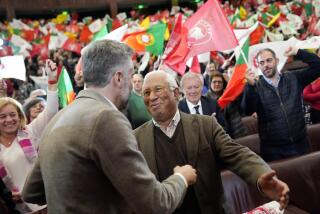ART REVIEW : ‘Gold’ Mines a Wealth of History : The Baroque Exhibition Sends Hopeful Message of Portugal’s Resiliency
- Share via
SAN DIEGO — “Gold and Grandeur: The Age of the Baroque in Portugal” is an exhibition with a story to tell. The story has two parts: One is of bristling international power and astounding aristocratic wealth in the 18th Century, which was suddenly shaken to the core by unspeakable devastation; the other is of how Portugal miraculously climbed back from ruin.
History is not the show’s only interest, however. “Gold and Grandeur” is plainly being offered as an allegory for Portugal’s precarious modern situation. As much as a sensuous wallow in often staggering past glories, it’s a pep talk for the present, too.
“Gold and Grandeur” began life as an exhibition last November at the National Gallery of Art in Washington. During the show’s run, plans to add the San Diego Museum of Art as its only other venue were announced.
It opened Sunday pretty much intact, although a few signal pieces have been deleted. A rather smallish exhibition, its 118 objects have been given a generous array of gallery space on two floors of the Balboa Park museum.
The show focuses almost exclusively on decorative arts--furniture, silver services, porcelain and faience pots, jewelry, religious vestments and such--including the blue-and-white painted tile panels called azulejos common to Portugal. A monumental azulejo panorama showing early 18th-Century Lisbon--it’s 66 feet long--is among those few works that haven’t made the westward trek.
Also, unless you see the show by the end of the first week in June, you’ll miss one of its most arresting religious objects: the “Sacramento Monstrance” (circa 1760), an astonishing sculptural concoction for displaying a consecrated host behind a glass window surrounded by a halo of jewels. A life-size, genuflecting angel of gilded, polychromed wood holds aloft a 400-pound sphere of highly polished, jewel-encrusted silver surrounded by an aureole of tapering silver rays. The monstrance towers over mere mortals who stand before it.
The composition is based on the classical motif of Atlas struggling to carry the heavens on his shoulders. Unlike the pagan Titan, however, this angel isn’t working up a sweat.
An unknown craftsman designed the monumental monstrance with such illusionistic skill as to make the huge, light-reflective silver sphere appear to float serenely in the space above the enraptured angel’s head. Since the ostentatiously displayed wafer represents the body of Christ that miraculously ascended into the heavens, it’s a powerfully realized metaphor.
The “Sacramento Monstrance” will be removed from the show June 6 because it must return to Portugal to serve as the identifying logo for Lisbon ‘94, a yearlong arts festival. Lisbon is this year’s so-called “Capital of Culture,” a changing designation made annually by the European Union to help boost tourism and trade among its member nations.
*
For Portugal, the designation is significant. Since the mid-1980s, its free-marketeer prime minister, Anibal Cavaco Silva, has directed landmark growth; the once-isolated nation on the Atlantic end of the Iberian Peninsula has been integrated into the European Union. Recently, the country climbed out of the economic cellar among EU member-nations, surpassing Greece.
The American museum exhibition is important to Portugal, too. U.S. loan shows of foreign treasures often carry symbolic weight to bolster pragmatic goals. In the 1970s, artifacts from King Tut’s tomb helped prepare the way for a dramatic change in Middle East foreign policy. In the 1980s, “Mexico: Splendors of Thirty Centuries” underscored an ongoing shift toward economic privatization in Mexico and helped grease the wheels for NAFTA.
In the 1990s, Portugal is making a bid. The aspirations for “Gold and Grandeur” might not be extravagant, but they’re unmistakable nonetheless. As the small, poor nation labors to dramatically increase economic growth and to reach out to an international marketplace, it has assembled an exhibition that celebrates the remarkable fruits of an earlier period of phenomenal expansion.
Portugal in the 18th Century was incalculably rich, thanks to a firm foundation of colonialist exploits around the globe. With the uncovering of huge deposits of gold, diamonds and other precious stones in Brazil, the little kingdom was catapulted into the stratosphere of European powers.
European Baroque culture is marked by rambunctious designs depicting expansive growth, organic profusion and constant movement. In painting, horizon lines often lower or even disappear, replaced by pictorial suggestions of infinity. Sculptural stasis is banished, in favor of swirling dynamism or voluminous airiness. Luxury abounds.
The show, which features spectacular samples from the world’s largest collection of royal silver and enough gigantic jewels to choke De Beers, attests to the Portuguese dream of rivaling France’s aristocracy in its glutted display of sumptuous excess. Designs indigenous to China, Brazil and other sites of Portuguese conquest are reinterpreted in writing desks and pottery. And much of the work in the exhibition wasn’t made in Portugal; instead it reflects Portuguese taste, and the economic power to import products of skill and fashion from England, France, Italy and Germany.
The dominant Baroque motif of lush, organic growth added a blaring aura of moral rightness to the Colonial carnage necessary to maintain such rapacious pomp. The style made power seem a force of nature.
Nowhere is the political use of Baroque imagery more outrageous than in an immense carriage meant to carry a Portuguese ambassador to the Vatican to wow the Pope. The carriage’s back end, which approaches the complexity of a Rose Parade float, features a gilded carving of the personification of Portugal, attended by allegorical figures of prosperity and triumph, lording over a captive Moor and a vanquished Turk. The captives are portrayed as entirely too satisfied with their ignominious fate.
All this gold and grandeur was rudely interrupted in 1755, however, when an earthquake said to have shaken for some 13 minutes reduced Lisbon to a pile of gilded rubble. The temblor killed more than 10,000 inhabitants (the king, by chance, was out of town), set off nine days of raging fires and destroyed countless artistic treasures.
*
Eighteenth-Century Pat Robertsons declared the natural disaster to be God’s revenge on a profligate people. The monarch, bolstered by the iron will of the brilliant Marques de Pombal, nonetheless proceeded to rebuild the city on a modern, rationalist plan. The diamonds encrusting subsequent jewelry got even bigger.
One of the show’s two paintings, installed at the entrance, is a stiff, 1766 portrait of Pombal seated high above a serenely rebuilt Lisbon, his masterful reconstruction plans strewn at his feet and sky’s-the-limit clouds rolling past his head. The painting is dull and didactic, but its symbolism for present-day Portugal is striking.
Portugal, led by its Capital of Culture, is celebrating the 20th anniversary of the start of recovery from its contemporary equivalent to the brutal destruction caused by the 18th-Century earthquake. In 1974 the vicious, 40-year rule of Western Europe’s longest-lived modern dictator, Antonio Salazar, came to an end. “Gold and Grandeur: The Age of the Baroque in Portugal” looks back at an earlier moment of prosperity interrupted by cruel disaster.
Indeed, the show’s dazzling display seems almost as calculated as the gilded back-end of the ambassadorial carriage that is its centerpiece. We came back from ruin once, the show forthrightly declares; surely we can do it again.
* San Diego Museum of Art, Balboa Park, (619) 232-7931, through Sept. 6; closed Mondays.
More to Read
The biggest entertainment stories
Get our big stories about Hollywood, film, television, music, arts, culture and more right in your inbox as soon as they publish.
You may occasionally receive promotional content from the Los Angeles Times.











